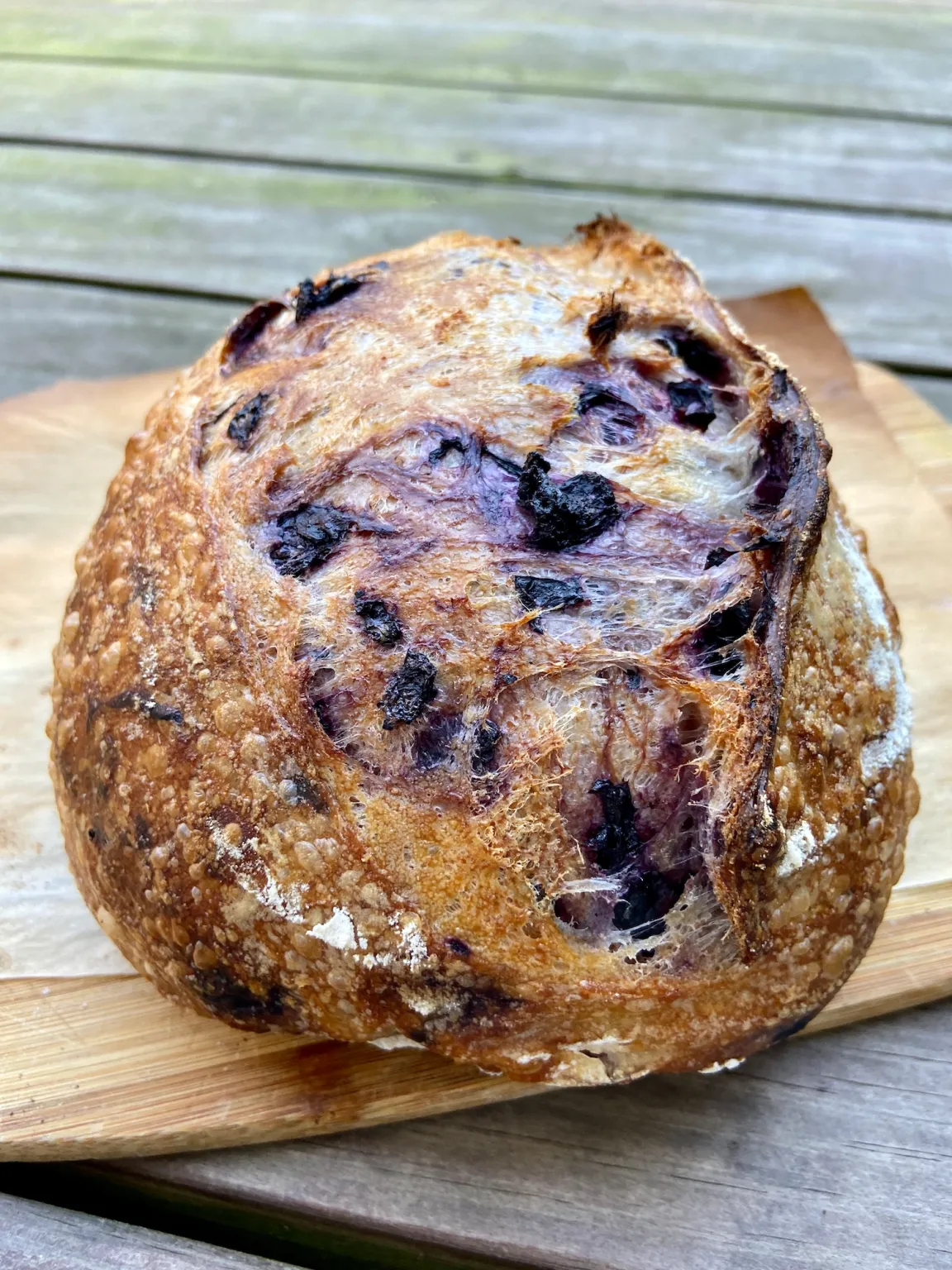Blueberry Sourdough
 If you want to bake a blueberry sourdough bread and not a blueberry pie, I recommend you only use blueberry skins as opposed to whole berries. This way you get the flavor and preserved bread structure by removing the excess moisture.
If you want to bake a blueberry sourdough bread and not a blueberry pie, I recommend you only use blueberry skins as opposed to whole berries. This way you get the flavor and preserved bread structure by removing the excess moisture.Add some goat cheese on top and a drizzle of honey.
Gosh… that’s heaven in your mouth!
Ingredients
Sourdough starter
- 5g sourdough starter
- 35g water
- 30g all purpose flour or bread flour
- 5g rye flour
Dough
- 270g bread flour (90%)
- 30g stone ground whole wheat flour (10%)
- 207g water (69%)
- 15g (5%) cold water added along with salt
- 300g blueberries mashed up, and only skins used for the dough.
- 60g levain (20%)
- 6g salt (2%)
Directions
Starter:
- 7 am add starter to the water and whisk together, add flour, mix well, cover loosely, let it sit at a room temp 74-78F for about 8-10 hours until starter reaches its peak (at least triples in volume).
Dough:
- 5 pm mix water with flour and cover, let it rest 1 hour for autolyse.
- During the autolyse process flour absorbs water, becoming fully hydrated. This activates gluten development.
- 6 pm add sourdough starter.
- Mix on low speed of your mixing machine for 2-3 min, or KitchenAid on speed 3 for 3-4 min until well incorporated.
- Cover, let it rest for 30 min.
- 6:30 pm add salt and extra water.
- The process of adding extra water is called bassinage, it helps to tighten up gluten. Mix on low speed of your mixing machine for 2-3 min, or with KitchenAid on speed 3 for 5-6 min until well incorporated. The dough should come up together, but still be sticky on the bottom.
- Continue gluten development and structure building by performing stretches and folds during the warm fermentation period.
- Leave to rest 30 min. At 74-78F /23-26C.
- Meanwhile mash up the blueberries, separate the skins and dry them with paper towel to make them less moist.
- 7 pm spray your work surface with water, wet your hands to perform lamination.
- Lamination is the process of stretching the dough as thin as you can without ripping it.
- Spread the blueberry skins all over the dough, fold and it let rest for 45 minutes.
- 7:45 pm 1st stretch and fold.
- 8:30 pm 2nd stretch and fold.
- 9.15 pm 3rd stretch and fold
Performing stretches and folds will help with gluten development. Keep monitoring the dough, if it rises too fast, you can shorten the time between stretches to 40 minutes or less.
After the final stretch let the dough proof for 30 minutes at 76-80F/ 23-26C. You should see some bubbles on the surface, the dough has to become lighter. We are looking for 40%-50% rise.
Preshaping sourdough
- 9:45 pm transfer the dough on to a work surface and dust its top with flour. Flip the dough over so the floured side faces down.
- Fold the dough onto itself so the flour on the surface remains entirely on the outside of the loaf. This will become the crust.
- Place the dough round on a work surface and let it rest for 30 minutes uncovered.

Shaping sourdough
- 10.15 pm dust the dough with flour. Use a dough scraper to flip it over on to a work surface so the floured sides face down.
- Starting with the side closest to you, pull the right 2 corners of the dough to the left, then fold them up into half of the dough. Repeat this action with the other side too.
- Finally, roll the dough. Shape it into a smooth, taut roll.
- Transfer the roll, seam side up, to a prepared proofing basket (loaf pan with kitchen towel).
- Cover it with plastic and return the dough to the 80F (27C) environment for 15 minutes.
- Then transfer the dough to rise for 14-24 hours in the refrigerator.
Baking
Next morning:
- Preheat your oven to 500 F, place a cast iron pan with the lid inside for 45 minutes -1 hour.
- Remove the dough from the fridge.
- Flip it over on a parchment paper, score it with a sharp knife or a scoring lame.
- Transfer on to the hot cast iron pan, cover with the lid (to create steam for a beautiful and crusty crumb).

- Bake at 500F for 15 minutes with lid on.
- Remove the lid, lower temperature to 450F.
- Bake for 20 more minutes until golden brown.








